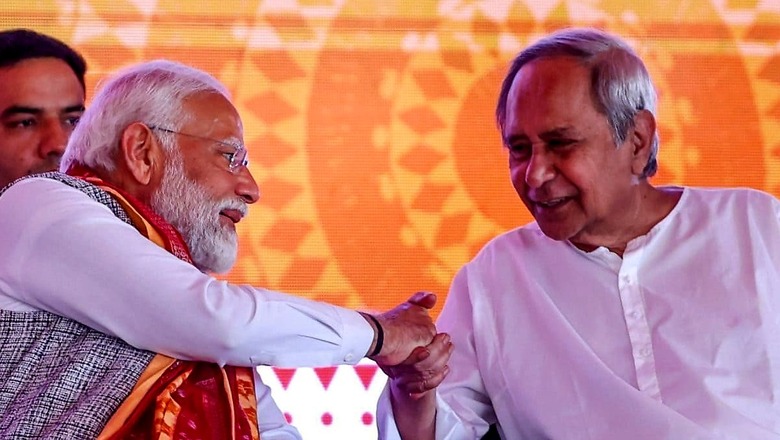
views
The relationship between Odisha Chief Minister Naveen Patnaik and Prime Minister Narendra Modi can best be described as “frenemies”. And now it seems the frenemies have a common purpose. Or perhaps, this cross-aisle cooperation stems from pragmatism. The ruling Biju Janata Dal (BJD) in Odisha could be joining forces with the BJP ahead of the upcoming Lok Sabha elections. The signs of a unity ticket were evident in the public display of goodwill between the two leaders.
When politicians praise each other, there is always a game plan.
Ostensibly, ‘Rising Odisha’ seems to be the central idea of the BJD ‘forging an alliance’ with the BJP. But the key reason is Naveen Patnaik’s party needs funds for various projects in Odisha and the “double engine government will help the state”.
Perhaps Odisha has taken a leaf out of the Telangana playbook. Revanth Reddy, Chief Minister of the Congress party in Telangana, calls PM Modi his elder brother while seeking funds from the Centre for development projects. Modi picked the moment to unveil and kickstart projects over Rs 56,000 crore in Adilabad. So, it makes perfect sense to have a good working relationship with the Centre.
Patnaik is the longest-serving chief minister of Odisha and as of 2024, one of the longest-serving chief ministers of any Indian state, holding the post for over two decades. He is only the second Indian chief minister to win five consecutive terms.
But there is also a sense of disquiet in Odisha with the dependence of Patnaik on his bureaucrat generals, many of whom are non-Odiyas. But it would be safe to say that his trusted aide VK Pandian, who recently retired from the civil services (IAS), was a key architect in bringing both parties together by holding one-on-one talks with Home Minister Amit Shah.
Other possible factors – there is a definite groundswell of support for the BJP in the urban belts of Odisha, despite the CM’s popularity with women, the anti-incumbency issue can’t be ignored and Patnaik’s limited campaigning could cost the BJD.
In elections, the numbers hold the main story. So, let’s have a look:
The strategic importance of Odisha, with its 21 Lok Sabha seats and 147 Assembly seats, is not lost on either party. In the 2019 elections, the BJD and BJP secured 12 and eight parliamentary constituencies and 112 and 23 Assembly constituencies, respectively. The main strategy is likely to be the BJP contests the majority of Lok Sabha seats, while the BJD focuses on Assembly seats.
For the Assembly elections, the BJD is pushing for a larger share of seats, proposing to contest 105 out of the 147 available seats, leaving the BJP with 42 seats. Simultaneously, in the Lok Sabha polls, the BJP is expected to secure a significant portion of the seats. Of the 21 Lok Sabha seats in Odisha, the BJP is likely to contest on 13-14.
Old Pact Between BJP and BJD
While the figures suggest a fair deal, the historical partnership between the parties also merits consideration. A potential pact between the two parties marks a significant shift in the political dynamics of the state, especially considering the BJD’s departure from the National Democratic Alliance (NDA) 15 years ago. Then, former BJP leader and minister Sushma Swaraj took a dig at Naveen Patnaik saying he would “regret” snapping ties after an 11-year understanding.
What Happened in 2009?
History should be remembered as echoes of the past resonate in the present, shaping the bond between these two groups. The BJD-BJP alliance saw success in two Assembly elections and three Lok Sabha polls in Odisha. The partnership, forged in February 1998, enjoyed a strong foundation, with both parties successfully contesting Lok Sabha elections in 1998, 1999, and 2004, as well as Assembly elections in 2000 and 2004. Once considered the BJP’s most reliable ally in the NDA, the alliance collapsed in 2009 following failed seat-sharing talks.
Breakdown in 2009
The breakdown happened when the BJD wanted to cut down BJP’s share of Assembly seats from 63 to around 40, and parliamentary seats from nine to six. BJP leaders found this demand unreasonable. And that was the trigger which led to the withdrawal of support to Naveen Patnaik’s government, marking the end of an 11-year political marriage.
The withdrawal of support was termed by BJD as an “act of betrayal”.
The BJD-BJP pact was formed in 1998, orchestrated by senior leaders Bijay Mohapatra and the late Pramod Mahajan.
Cut to the present, the significant part of a BJD press statement says: “It was resolved that since by 2036, Odisha will complete 100 years of its statehood, and BJD and Chief Minister Patnaik have major milestones to be achieved by this time, therefore Biju Janata Dal will do everything towards this in the greater interests of people of Odisha.”
As long as it is ‘Rising Odisha’, both parties would be on board.
The author is CEO of nnis, media entrepreneur, columnist, and guest expert on TV shows. Views expressed in the above piece are personal and solely those of the author. They do not necessarily reflect News18’s views.


















Comments
0 comment